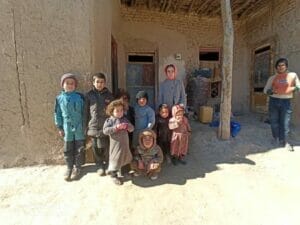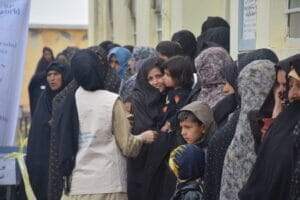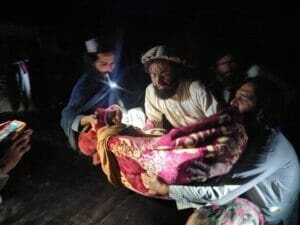
A year has gone by since the entire world was watching the dramatic scenes that were taking place in Afghanistan. However, the attention of international media did not take long in switching elsewhere, focusing on other humanitarian crises and relegating the Asiatic country to the second page, if not almost completely forgotten, In the meanwhile, the conditions of the population have precipitated into an alarming deterioration.
The humanitarian overview
The country has experienced 40 years of war and hunger, financial straits, poverty and internal displacements have been a reality for a long time. However, the return of the Taliban authorities last August, followed by the initial halt of international humanitarian aid, highly exacerbated these phenomena. Today, more than half of the population – 24,4 million people-, are in need of lifesaving humanitarian assistance. In 2021, they were 18.4 million, and the year before 9.4. Furthermore, the Afghan population, almost entirely below the poverty line and growing fast, is also one of the youngest worldwide.
In such a context, any further shock, either man or nature induced, would have a huge repercussion in the country. In fact, the earthquake that struck the southeastern provinces along the border with Pakistan on June 22 is a proof of this: while humanitarian operators mobilized quickly and had access to the affected areas, the rescue activities were hindered by the lack of resources and the very limited access to local health structures. The people that remained homeless are widening the already-large ranks of the millions already in need of emergency shelter assistance.
The national health system, which until last year was highly dependent on the international community assistance, has very few structures and resources left. Today, together with diseases such as measles and cholera, corruption practices are spreading, and the few medical services are often conditioned to personal benefits.
The climate strains
Alongside the abovementioned highly severe crises, the Afghan population is also experiencing the merciless effects of the climate change. Last winter was particularly harsh and the heavy snowstorms blocked many roads, further compromising access to essential goods and services. On the other side, the country has been brought to its knees by a very strong drought, which has compromised the production of the traditional crops. As a result, deep-rooted rural customs, such as subsistence economy and solidarity among neighbors, are no longer sustainable and hunger is spreading. Today, 23 million people suffer from food insecurity – a 35% increase compared to last year and the highest number currently registered worldwide in a single country. The daily extreme difficulties are gradually tearing apart the social fabric and 3.5 million Afghans are estimated to be addicted to opioids, which they consume to avoid work fatigue, but also to cope with hunger or psychosocial issues.
The position of women and children under the new regime
For human rights as for Afghan women, the return of the Taliban to power has entailed the gradual but strong reinstatement of restrictions and discriminations. As of today, women can no longer work nor travel further than 50 km from their homes without being accompanied by a male member of their family, a Mahram, and they have to wear an abaya – a long dress covering the whole body - and cover their faces in public spaces. Moreover, due to the high rate of men who have died in recent conflicts or as a result of the pandemic and other widespread diseases, over 2 million women have become widows nationwide. As their possibilities to find a job, or even of begging on the streets, are almost absent in the light of the abovementioned restrictions, women who find themselves at the head of their households rarely have a source of income. This privation of economic independence makes their survival conditions and their access to food, as well as those of who depend on them, at high risk.
Many children are compelled to drop school to work or to beg on the streets, with all the related psychological, developmental and physical risks. In the meantime, education has become a rarity rather than the right it should be, with more than 4 million children out of school. Moreover, this number has increased after March 23, when the secondary facilities for girls remained closed. In the Afghan context, for girls to attend secondary school is also a fundamental tool to tackle the traditional and spread use to force them into marriage. At last, one of the most dramatic consequences of the compounding restrictions and crises for the children is that of many of them who are abandoned in front of orphanages.
Children are therefore extremely vulnerable, with more than half of the population under five years old suffering from acute malnutrition. They are, along with their mothers and all the other women, the most affected by the compounding emergencies that are hitting the country: the same categories that WeWorld prioritizes in its operations worldwide.
The renewal of humanitarian aid
Despite the difficult penetrability of cash in the country due to the disrupted banking system, the negotiations with the authorities concerning the presence of women in the staff and as beneficiaries, and the reluctance of some donors due to the political situation, it has been gradually possible to reintroduce humanitarian aid programs of monetary nature. WeWorld has been able to operate again in the province of Herat thanks to local longstanding partner Rural Rehabilitation Association for Afghanistan (RRAA).
In the rural areas of the targeted territories, the drought has provoked major migration flows: some have managed to cross State borders, while others have joined the displaced masses surviving in the streets of the country's major cities. The few remaining residents of the Robat E Sangi area describe this past year as the worst they can remember. More than 70 km away from the nearest city, reachable by winding mountain roads often blocked by snowstorms or thick fog, the only sources of income are currently relegated to the few crops resistant to adverse conditions, such as licorice. In the villages, retailers buy 4 kg of roots for the equivalent of nearly 1 USD.
Our intervention
Since the end of 2021, WeWorld has been implementing a Cash for Food project in the abovementioned areas, precisely in support of the women who found themselves at the head of their families. 180 households are currently benefiting from the program, counting overall more than 1000 people of whom ¾ are children. A similar project will start this summer with 240 new families.
The severe lack of income has forced the families to adopt many negative mechanisms. To tackle them, the aid takes the form of a distribution of money and vouchers for the equivalent of 80 USD per month per family, for the purchase of food items and medicines. For some beneficiaries, the monetary assistance has been the only way for them to be able to stay and not risk their lives through migration, which was until little before the only plausible option to try to get by.
The stories of Afghan women are made of grueling barriers and enormous daily efforts. Their children are direct victims of this situation, forced to work, to get married and/or to go hungry. External support, which is currently the only available one, is more than ever vital and fundamental, as it is urgent. So far, WeWorld has undertaken 5 distributions. The intent is still to strengthen and make sustainable the cash for food assistance by extending it to a more comprehensive response including protection, emergency education, water access, sanitation and hygiene, and to scale up by reaching the left-behind people in need.



